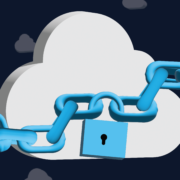It’s no surprise that cloud storage has taken the world by storm. Employees can access work documents and work from anywhere. Students and scholars can find reference material without access to the publishing institute. Individuals can store their files and access them without carrying around personal drives and memory cards. But when your data is accessible from anywhere – theoretically by anyone – security becomes the new concern.
In the digital age, the infrastructure of data, its costs, and its means of security have evolved over time. Organizations have always sought cutting-edge tools and solutions for their digital needs, which has led to the emergence of cloud services as a more scalable and secure option over on-prem services.
Early on, infrastructure for all data required the investment of all-prem services, short for on-premises. Data centers, their applications, and network solutions required hardware on company grounds. This setup also required server upkeep and security measures on-location to keep all data maintained, available, and uncompromised.
A cloud migration strategy is an organization’s plan of action for successfully moving data, applications, and processes onto a cloud platform. Such strategies become essential due to the requirements, data security, and costs that can differ from one dataset to another. Those differences require a variety of strategies in turn.
Cloud migration strategies apply whether an organization moves from local infrastructure to cloud infrastructure, moves from one cloud service to another, or sets up a hybrid cloud to leverage both local and cloud infrastructures.
When it comes to unstructured data in an organization, sensitive data is the most important type of data to identify. Sensitive data falls into several classifications, but broadly refers to data that must be protected from unauthorized access to prevent harm to businesses and individuals alike. These classifications include personal information, private information, health information, and high-risk data, among others.
The cloud-first priority shift is one of the biggest transformative changes impacting businesses as a result of Covid-19. According to Gartner, by 2024 more than 45% of IT spending on system infrastructure, infrastructure software, application software and business process outsourcing will shift from traditional solutions to cloud. And by 2025, 85% of large enterprises will have a cloud-first principle.
Cloud computing is one of the top three game-changing technologies, meaning many organizations regardless of size, industry, and technology will begin or increase their usage of the cloud. With that being said, according to Gartner’s most recent report, “through 2024, 80% of companies unaware of mistakes made by organizations in their cloud adoption will overspend in cloud by 20% to 50%.”
In recent years, there have been many technology innovations that have facilitated the shift from on-premise data storage to cloud data storage, such as creating hybrid solutions or implementing machine learning. Over 50% of an organization’s data is dark, which comes with a great deal of unnecessary and risky costs, such as storage and overhead, maintenance, and time costs. Dark data is the information assets organizations collect, process and store during regular activities, but the data generally is never used for other purposes like analytics. Classifying dark data comes with unprecedented benefits that will save organizations money and drive their product innovation and business strategies. In 2019, Gartner analysts believe that a hybrid storage approach will be the norm for IT departments. With data privacy regulation laws rising around the world and the growth of real-time data and forward-looking predictive analytics, it’s essential that companies act fast to classify and clean up their data.
Looking to move past hybrid cloud skepticism within your organization? Here are some best practices to ensure your data is being used to its greatest potential within a safe, controlled environment.
1. Discovery and Analysis
Many data management classification tools come along with data discovery. Businesses have valuable insights within their data that they don’t know exist. Implementing tools that can help you dig deep into your data and allows you to take action on your data will help get this started.
2. Classification and Organization
Failure to remain compliant with data and privacy laws leads to hefty fines and penalties. Organizing data is key to applying data regulation policies to data. This can be done by organizing data by its level of sensitivity or data type.
3. Cataloging and Management
Once all of your data is organized and classified, it is critical to document your findings. This allows people within the company and its consumers to have access to your organizations data and helps to better understand the format of data whether that means unstructured, semi-structured, or structured data.
4. Data Quality Management
It is important to get a feel for both your organization’s and consumers’ data needs so you can meet and exceed all agreed upon expectations. There are many management processes that can be implemented to meet data expectations including—control creation, quality monitoring and reporting, supporting processes, and data incident tracking. Incorporating proper data quality management techniques are crucial in ensuring that your organization has reliable data. Without the right management, unused data can quickly become a burden on an organization.
5. Access Management
Allowing customers to have access to their data is important for an organization to keep in mind. However, it is equally as important to incorporate proper prevention of access to data for those who are unauthorized. Establishing levels of managed access to data is a technique to prevent issues from happening in the future relating to access.
6. Auditing
Auditing and monitoring are key to preventing threats and risks in the future. It is important to audit regularly so that future problems can be acted upon before they occur.
7. Data Protection
Incorporating as many security measures as possible is key to keeping the upmost safety for your organizations data. You never know how quickly you can be hacked, and it can be detrimental to the company.
All of the tips can help your organization improve its data governance strategy especially in terms of migrating to the cloud. Check out our data governance tools and book an intro call with a member of Congruity360, today!
The benefits organizations can achieve by migrating to cloud environments are extensive and well-documented: businesses can realize increased agility and scalability, improve disaster recovery, strengthen security, and create space for new IT initiatives, among other advantages. But cloud migrations can be complex, costly, and intimidating. Many organizations know they want to leverage cloud technology but aren’t sure how to get started or even what type of cloud environment is best.












